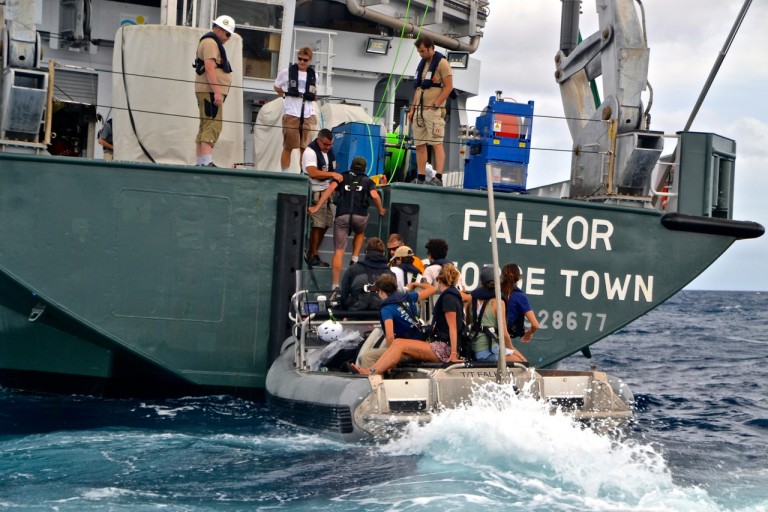The members of the second student cruise met the small boat Atreyu at the University of Hawaii’s Snug Harbor facility on a gray Easter afternoon. Departing from Falkor at the same time were the somewhat shell shocked members of this expedition’s first leg–many of whom had battled seasickness in the notoriously rough waters of the Molokai Channel.

We dropped our duffels and backpacks wrapped in plastic garbage bags into the bottom of the jet boat and powered out through the sea spray to meet Falkor waiting outside of Honolulu Harbor.
Onboard the crew was finishing up a rapid cabin changeover, and handing out room assignments to the new arrivals. We relaxed for about an hour as the captain navigated the ship west along the southern Oahu coast, rounding Barbers Point and continuing north towards the Kauai Ridge off of Kaena Point, Oahu.

Getting to Work
Over Easter dinner, the recruiting quietly began. “Florian, you have an engineering background, right?” chief scientist Glenn Carter asked Florian Hillenhagen.
The answer was yes, so as soon as Florian was done with his panna cotta, he was whisked up to the lab to construct a sturdy bracket. His goal was to attach a temperature sensor to the vertical microstructure profiler instrument that will be used in subsequent days’ research.

The profiler itself is used to measure turbulence, and will be deployed off Falkor at different times during tidal cycles to map small-scale current fluctuations. As for the temperature sensor, its original metal bracket had been lost at sea with another device during an earlier cruise, so Florian used only the tools and materials available in Falkor’s drawers to assemble an admirable substitute.
Ups and Downs
The crew dropped the CTD rosette into the water for the first time at about 8 p.m. on Sunday to begin the night’s work. What was originally envisioned as a roughly 12-hour tidal schedule of cycling the CTD up and down the water column was ultimately stretched until 1:30 p.m. today, as the equipment for the next set of experiments was not yet ready.
The up-and-down cycle of the CTD is commonly called a tow-yo manuever (think of a yo-yo motion, towing a CTD). In our case, the CTD traveled from about 50 meters below the surface to a depth of 400 meters, or 20 meters off the bottom, whichever was shallower.

To keep the process moving, students man the radio in shifts, communicating with the winch operator controlling the CTD’s depth. “Operator, this is science control,” said Ted Conroy as data streamed across the panel of computer monitors, “Haul in at 30 meters per minute.” Ultimately the students log all the information collected on a uniform data sheet.
The Big Jump
During this segment of the student cruise, our focus is internal tides off the western tip of Oahu. An internal tide is a wave formed below the sea surface by the turbulence generated as normal tides move water up and down slopes such as those at the base of our Hawaiian island.
We are focusing on Kauai Ridge because the effect is particularly pronounced in this area. Something of particular interest for the team is that during a previous cruise to this area researchers observed a phenomenon called a hydraulic jump.

In a hydraulic jump, the internal tide drives colder, denser water up over the ridge. Once over the ridge crest, gravity accelerates this water into a thin layer. This flow slows dramatically, and then the layer thickens dramatically or “jumps” up.
We will go into greater detail on how to visualize this jump—and the many effects that the associated turbulent mixing can have at the ridge—in future posts.

